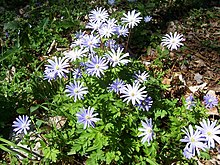Anemonoides apennina (syn. Anemone apennina), the Apennine anemone or blue anemone, is a flowering plant in the family Ranunculaceae.[1][2] It is a rhizomatous perennial plant, native to southern central Europe, taking its name from the Apennine Mountains, but widely naturalised elsewhere in Europe, including the United Kingdom.[3] It can be confused with Anemonoides nemorosa which it resembles. It grows to 20 cm. In early spring it produces single blue flowers above ferny foliage, which dies down in summer. The flowers are about 3.5 cm across, with 10-15 narrow petals. The leaves are palmate with dark green 3-lobed, toothed leaflets.[4] The leaves are hairy underneath, which is how this plant may be distinguished from the similar Anemone blanda.[5] It is especially valued for its ability to colonise deciduous woodlands, but it is also found in open scrub, under park trees, and near former habitation.[3] This plant has gained the Royal Horticultural Society's Award of Garden Merit.[2]
| Anemonoides apennina | |
|---|---|

| |
| Scientific classification | |
| Kingdom: | Plantae |
| Clade: | Tracheophytes |
| Clade: | Angiosperms |
| Clade: | Eudicots |
| Order: | Ranunculales |
| Family: | Ranunculaceae |
| Genus: | Anemonoides |
| Species: | A. apennina
|
| Binomial name | |
| Anemonoides apennina (L.) Holub
| |
| Synonyms[1] | |
| |
Eating A. apennina may cause mild stomach upset, and contact with the skin may cause irritation.[4]
References
edit- ^ a b "Anemonoides apennina (L.) Holub". Plants of the World Online. Royal Botanic Gardens, Kew. Retrieved 9 August 2020.
- ^ a b "RHS Plant Selector Anemone apennina AGM / RHS Gardening". Apps.rhs.org.uk. Retrieved 12 April 2020.
- ^ a b "Anemone apennina L." BSBI Plant Atlas 2020. Botanical Society of Britain and Ireland. Retrieved 15 April 2023.
- ^ a b Shoot. "Anemone apennina Apennine Blue Care Plant Varieties & Pruning Advice". www.shootgardening.co.uk. Retrieved 2021-05-03.
- ^ Fogliani, J.; Chauvin, G.; Pons, R.; Ohresser, P. (October 1975). "[Anesthesia and resuscitation of a thoracic-injured patient just arriving at the hospital]". Annales de l'anesthésiologie française. 16 (6): 1L – 6L. ISSN 0003-4061. PMID 2053.